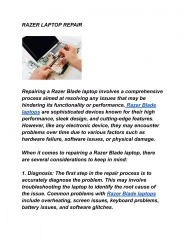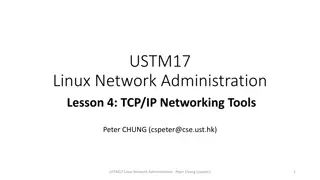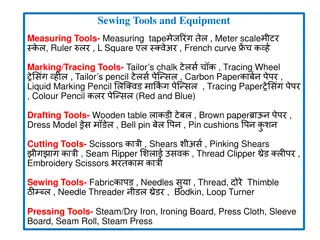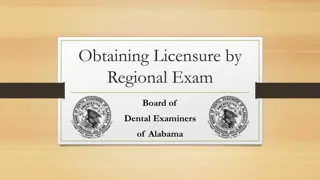Step-by-Step Guide for Replacing Board in CLAP Tools
In this detailed guide, learn how to replace the board in CLAP tools with the help of essential items like a flashlight, small Philips screwdriver, spacer tool, tape rolls, and more. Follow each step carefully to ensure a successful board replacement without damaging any components.
Download Presentation

Please find below an Image/Link to download the presentation.
The content on the website is provided AS IS for your information and personal use only. It may not be sold, licensed, or shared on other websites without obtaining consent from the author.If you encounter any issues during the download, it is possible that the publisher has removed the file from their server.
You are allowed to download the files provided on this website for personal or commercial use, subject to the condition that they are used lawfully. All files are the property of their respective owners.
The content on the website is provided AS IS for your information and personal use only. It may not be sold, licensed, or shared on other websites without obtaining consent from the author.
E N D
Presentation Transcript
Replacing board in CLAP Tools: Flashlight (torch for those of you in Cape Town)) small philips screwdriver spacer tool* dish to hold screws 2 rolls of tape to support removed CLAP head *Depending on the CLAP, the spacer tool should be a broad flat but thin blade or a 6mm socket wrench (spanner) with a piece of vinyl tubing inside the socket part. I ve included the first. More details in a further slide. Three important notes: (1) There are two types of screws used in the CLAP machine screws and sheet metal screws. You will only be removing machine screws. (see next slide) (2) Be careful to not cross thread things (especially the spacers steps 9 and 13) (3) Be careful not to bend connector pins, this is where the flashlight will come in handy.
Machine screws versus sheet metal screws in the CLAP The machine screws are slightly longer than the sheet metal and have more finer threads. Don t worry this document shows you which ones are which and specifically which should be removed. We just want you to be aware that there are two types of screws and that they shouldn t be interchanged!
Step 1. Remove the top layer of machine screws from the sides of the CLAP there are 10: 3 on the front, 3 on the back and 2 on each side. These screws are indicated by the pink arrows. Step 2. Loosen (but don t remove) the top sheet metal screws on the front and back. You are loosening 2 sheet metal screws on the front and 2 sheet metal screws on the back. The blue arrows show the sheet metal screws on the front. Also loosen the equivalent screws on the back. This is a setpin DON T touch
Step 3. Carefully lift CLAP head from body of clap, flip upside down and rest in inside of tape roll (there are wires and tubes that go between head and body of CLAP the tape roll provides support for CLAP head and strain relief for wires. CLAP inlet tube Solenoids and such Clap head CLAP inlet tube tape tape 1 roll of tape, you ll probably need 2 rolls
Step 4. Note that the CLAP head is labeled F for front and R for rear. You will want to be sure that when you put it back together the F goes in the FRONT! F for front (sorry it s blurry)
Step 5. Remove 2 connectors from their sockets. One socket is a long white socket with a connector with lots of colored wires and the other is a smaller white socket Big connector (just outside of picture) It came from here Wires connected to big connector and to CLAP body Sockets with connectors removed This cable/connector is still in socket
Step 6. Disconnect solenoid connectors by pulling up on black connector. There are 10 solenoids be sure they are all disconnected. Solenoid connector Solenoid connector socket
Step 7. Remove the 5 machine screws holding the top board to the CLAP head. These screws are identical to the machine screws you removed in Step 1. The pink arrows indicate the screw locations. The blue arrows show the holes where the screws have been removed.
Step 8. Carefully pop up the top board. Try to do this as vertically as possible. It is connected to the board underneath by electrical connectors with thin pins you don t want to bend the pins! Also note the orientation of the connectors so when you replace the top board you have it in the right orientation. Connectors on top board indicated by pink arrows. Thin pins that go into connectors are in pink circles. Lay the top board aside somewhere safe, you will be putting it back into the CLAP shortly.
Step 9. remove the 5 aluminum spacers on the second board. For this youll need either a spacer tool like the one pictured below or a 6mm socket with vinyl tubing shoved into it. Be careful not to cross thread the spacers. Picture of our home made spacer tool. The blade is thin like a small screwdriver, but wide like a big screwdriver Second board with 2 of the 5 spacers removed. Pink arrows indicate the 3 remaining spacers. Blue arrows indicate the location of the 2 removed spacers.
Step 10. Lift up the second board to remove it from the clap head. Again, lift it vertically. It is connected to the board underneath by electrical connectors with thin pins you don t want to bend the pins! This is the board you are going to replace Pink arrows indicate connector sockets; Pink circles are the thin pins that go into those sockets. Note that the connectors aren t symmetrically located around the circular board they can only fit together one way! Please send the old board back to us so we can diagnose it.
Step 11. Remove new board from static pouch. Youll note that it looks slightly different this is because we ve added a heat sink (piece of metal) to a chip that was overheating. You are now going to go backwards in these steps to put the CLAP back together with the new board. I ll describe the process in words, but please refer to the previous pictures if needed. Step 12. Line up the thin connector pins with the connectors on the new board. A flashlight might be handy here. Once you have the connectors/pins lined up press down the board so it is connected to the CLAP head. Again be careful you don t want to bend/break pins. Step 13. Re-install the aluminum spacers. Be careful not to strip the threads. Hand tighten them first and then use your spacer tool to finish tightening the spacers. Step 14. Line up the connector pins on the new board with the connectors on the top board. This is harder because these connectors have double rows of pins. Again be careful not to bend/break pins. You can use the spacer holes as a secondary means of lining up the pins, but the pins are the critical thing to get lined up. Step 15. Reinstall the 5 machine screws on the top board (see step 7).
Step 16. Reconnect the 10 solenoid connectors (see step 6). Its good to actually count that you ve made all 10 connections. Step 17. Reconnect the 2 connectors on the top board (see step 5). At this point you can temporarily supply power to the CLAP to see if all is well. You should see the front flow display has a readout and the colored lights should be blinking. DISCONNECT POWER before continuing. Step 18. Reinstall the CLAP head back into the CLAP body (see step 3/4). Make sure the F goes in the front. Be careful not to pinch wires or tubes when doing this. Step 19. Tighten the 4 sheet metal screws that you loosened in step 2. Step 20. Replace the 10 machine screws that you removed in step 1. The CLAP should now be ready to reinstall in the aerosol system. You will need to do a white filter check, but the calibrations will remain the same.























